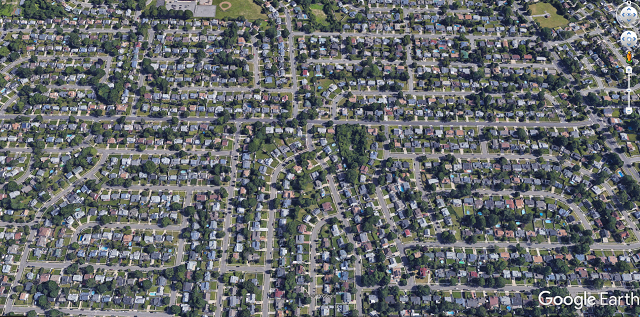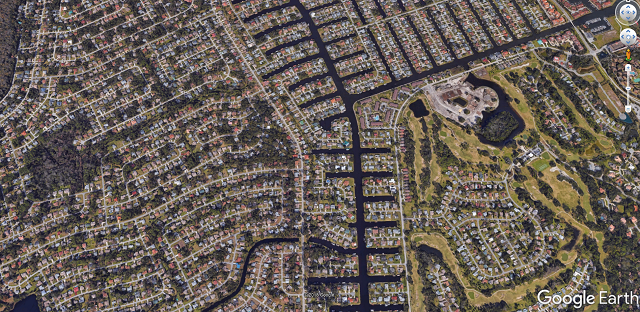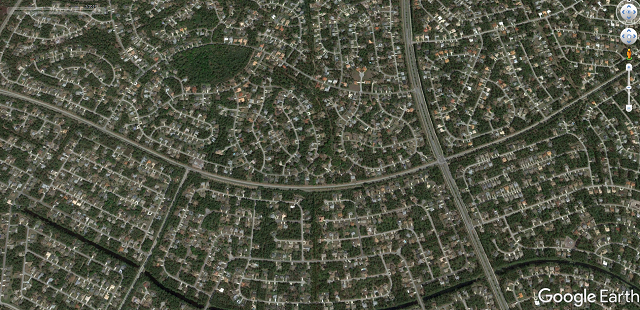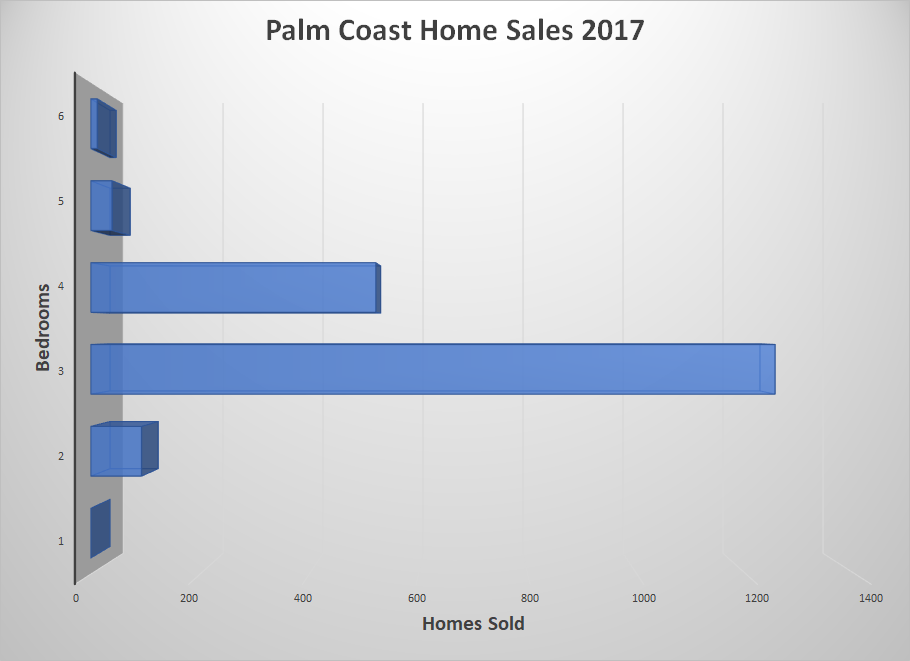Has ITT’s Master Plan for Palm Coast Run Its Course?
Palm Coast’s homogeneous housing stock is woefully inadequate. The case for more residential density and housing diversity gains momentum.
PALM COAST, FL – April 20, 2018 – ITT’s master plan for Palm Coast has run its course. Population growth, changing demographics, and technology are rendering our growth management template obsolete as Palm Coast and Flagler County continue to plan growth around the ITT/Levitt model.
In the early 1970s, ITT planned and began developing Palm Coast as the largest master-planned community in the country at the time. ITT’s planning partner was Levitt & Sons, the company that invented urban sprawl following WWII with seven Long Island housing developments collectively known as Levittown.
LEVITTOWN, LONG ISLAND

Palm Coast was planned to be different, not block after block of sameness. Palm Coast has miles of saltwater and fresh water canals. Residences are located off and away from busy thoroughfares. Golf courses were interspersed among the homes. Homes were required to be painted with warm earth tones. Over 40,000 lots were platted; nearly all with 10,000 square feet of land. Extensive landscaping and setbacks were required. Commercial signage was heavily restricted.
PALM COAST (C SECTION)

The result; Palm Coast is beautiful. Visitors are universally struck by the city’s uncluttered beauty, with its arching Spanish moss-covered live oaks. Its newness precludes urban decay. As of August 2017, the median age of an existing home in Flagler County was only 17 years. In Palm Coast, the median was a mere 15 years.
Palm Coast has been recognized as one of “America’s 50 best cities to live.” Palm Coast is relatively affordable too. From a recent study of retirement options highlighted in the Palm Beach Sun-Sentinel; “Of the 11 urban areas compared in Florida, a $1M retirement account lasts longest (32.5 years) in Palm Coast…” (BTW, New York City was at the bottom of the national list at only 12.5 years.) Yet the report describes Palm Coast not as a beautiful place to live but as a “sprawling suburb.” While there are no homes directly on thoroughfares in Palm Coast, sprawl is still evident. Rather than neighborhood commercial centers within walking distance, Palm Coast has scattered gas station/convenience stores.
PALM COAST (P AND R SECTIONS)

I, for one, love Palm Coast. I often talk about the quality of life here, but when someone asks why I love it so much, I don’t say, “it’s because of the suburban sprawl. Palm Coast has much to brag about, but 40 years of growth and changing demographics have uncovered warts in the ITT/Levitt plan.
Swales, Ditches, and Canals
Palm Coast’s stormwater management system of swales, ditches, and canals not only cost less to build than a traditional curb and gutter system, but it is also very efficient. Over the years, city property owners have suffered only minor flooding damage, even during two recent hurricanes. Unfortunately, swales preclude sidewalks in most of Palm Coast’s residential areas.
Palm Coast and Flagler County have well over 100 miles of well-built paths and walkways for biking, jogging, and walking. Yet, almost all errands require a car. Trulia says that 100% of Palm Coast residents commute by car. Via Public Transportation, 0%. Walking, 0%. By bike, 0%.
Palm Coast’s street layout puts homes in cul-de-sac-like neighborhoods isolated from main thoroughfares. This design keeps heavy traffic out of residential areas but makes traditional public transportation impractical. People are not likely to walk as far as two miles from deep within the “P” Section to a bus stop on Belle Terre.
Walkability
WalkScore.com says, “The 202 largest cities in Florida (the most populous cities in FL are Jacksonville, Miami, and Tampa) have an average Walk Score of 32. The best cities in Florida ranked by Walk Score are Miami (walk score 79), Miami Beach (76), and Hialeah (69), while the least walkable cities are Poinciana (4), The Acreage (5), and Palm Coast (7).” Zip code 32164 has a walk score of only 4. Only one resident in ten living within the 32164 zip code can walk to a restaurant, bar or coffee shop in five minutes.
Several factors have contributed to Palm Coast’s suburban sprawl. First is zoning. Palm Coast requires a single-family residential (SFR) home to have at least 1,200 square feet of living area with a two-car garage. Essentially, that’s a three bedroom, two-bath house. Allowable SFR densities are 7 seven units per acre for 50 ft. lots, five units per acre for 60 ft. lots, and four units per acre for 80 ft. lots.
Duplexes can have as little as 800 square feet of living area, but the number of available city lots designated for duplexes is limited. Only 135 duplex building permits were issued by Palm Coast between 2005 and 2017. There are currently 816 duplexes in the city.
Medium density multi-family buildings (condos and apartments) are limited to eight living units per acre while high density allows 12 per acre. Allowable multi-family density in nearby Ormond Beach is more than double Palm Coast’s.
There have been no multi-family permits issued in the county or the city in over three years. The city currently has only 1,694 condominium units, 1,147 apartment units, and four mobile homes compared to 32,421 SFRs.
Residential density is important because it attracts nearby commercial development and jobs, resulting in a much higher Walk Score. Higher density multi-family developments support higher quality construction, a broader array of amenities, and on-site management. Low-density developments exhaust developer’s budgets, promoting residential-only sprawl. Without nearby shopping, restaurants, and jobs, residents must rely on their automobile.
Impact and utility connection fees play a role in promoting suburban sprawl too. A Palm Coast SFR permit requires fee payments of roughly $17,000 per home, regardless of size. This “tax” is highly regressive. A buyer of a 1,200 SF home ends up with a $14.17 per square foot surcharge, while the per square foot fee burden is only $6.80 for a 2,500 square foot house. It comprises more than 11% of the cost of a $150,000 house but only 3.4% of a $500,000 house.
It costs more than $500 per lot frontage foot to provide infrastructure in a new development, exclusive of entry features, additional lift stations, amenities, land acquisition costs, land use changes, permitting, and a spine road. It’s just cost prohibitive to have 80′ and 100′ lots.
Tribalism and NIMBYism
It’s natural that people are most comfortable living around people who are like themselves, culturally and economically, even age. Yet these same people want readily available services such as healthcare, schools, police and fire protection, restaurants, homebuilders, branded retail stores and locally owned businesses. Our workforce needs to live in the community, convenient to their workplace. A healthy housing stock profile makes room for people in all stages of life and on all rungs of the economic ladder as well as people, young or old, who simply desire less space and lower maintenance needs.
Technology
The autonomous automobile and ride-sharing services, such as Uber, will quickly transform transportation. The smartphone has become ubiquitous in only ten years. tt has revolutionized our lives. Few people use a traditional camera. I don’t wear a watch anymore. We pay at Starbucks, surf the Internet and get our news with our smartphones. Texting is replacing email. Our language and vocabulary have been changed. I have a granddaughter in Washington DC in her mid-20s. She has neither a car nor a license to drive one. She has a smartphone with the Uber app. She certainly does not need a two-car garage. Most children born today will never own or drive a car. Residential and commercial planners with vision are already talking about repurposing vast parking lots and about designing specifically for expanded dropoff and pickup locations.
Palm Coast’s Housing Stock Profile
Palm Coast’s homogenous housing stock is woefully inadequate. The city’s population growth is outstripping the capacity of labor-constrained home builders. With demand exceeding supply, home prices and rents are rising; faster than income growth, resulting in an affordability crisis. The year to date, the median selling price for a single-family home in the city is $206,000 ($218,800 for all of Flagler County). Trulia pegs the median monthly rent at $1,385.
Of nearly 600 single-family Palm Coast homes listed in the local MLS, 59% have three bedrooms. Another 35% have four bedrooms, leaving only 6% for “all other.” There are no one-bedroom homes listed and only 15 two-bedroom homes listed.
.png)
Demand for Smaller Homes
Of 1,920 single-family Palm Coast homes sold via MLS in 2017, fully 65.4% were three-bedroom. There were no one-bedroom homes sold during the entire year. While two-bedroom homes comprise only 2.56% of listings, they accounted for 4.84% of 2017 home sales. Two-bedroom homes sold more quickly too. The Median Days on Market (DOM) for two-bedroom homes was only 21 days. For three-bedroom and four-bedroom homes, DOM was 37 and 57 days respectively.

Only one one-bedroom home has been sold in Palm Coast (via MLS) in the past ten years. This home was built in 1973.
What does this tell us? There is a pent-up demand for smaller homes. I would argue that there is also a substantial demand for homes too small to be built under the current Land Development Code.
Economic Development Implications
Flagler County has an active program to attract target industries. Among them are:
- Advanced Manufacturing
- Aviation/Aerospace
- Life Sciences
- High Technology
At the same time, Flagler Schools are gaining an international reputation for their Flagship program (Classrooms to Careers) which prepares students for an array of career paths beginning in elementary school. These programs include:
- Innovation
- Robotics
- Engineering
- Computer Science
- STEM
- Green Technologies
- Agronomy
- Marine Science
- Medical Science
- International Baccalaureate
- Biotechnology
- Firefighting/Law Enforcement/Judicial
These laudatory programs are creating our future workforce and augmenting the county’s economic development efforts. Our young people will graduate prepared to enter a local workforce of target industries. Success will enhance our area’s economic stability and shift some of the property tax burden from residential to commercial and industrial.
However, employers and a qualified local workforce are only two legs of a three-legged stool. The employees need to have a place to live and play. Look at the list of target industries. Does their workforce consist of affluent retirees from the northeast? No. They are millennials. They are members of the X or Y generation; some with heavy student debt. They will have become comfortable using ride-sharing services. Not all of them will gravitate towards three and four-bedroom homes with two-car garages. Many will be renters.
Lifestyle and economics will guide and limit their living options. Zoning must make room for them. Without workforce housing, economic development efforts will fall short. Our remarkable schools will not create local workers. Rather, they will become our most successful export industry, training our children to go somewhere else to pursue their dream careers. And the local property tax burden will fall entirely on the residential sector.
Upcoming Changes
At a recent meeting, Palm Coast’s Planning and Land Development Regulation Board (PLDRB) acted on a proposed ordinance to amend the Transportation, Connectivity, Access and Parking section of the Unified Land Development Code. They recommended that City Council approve the ordinance but with a key modification; one-car garages to be permitted (not required) within all residential categories (including SFR). In other words, the new minimum will likely be a one-car garage.
Also recent, City Council heard a presentation by staff of a proposed new initiative for Town Center. The idea is to delineate an overlay Innovation District within Town Center that will encourage more diverse housing products. Among the ideas are smaller residential lots (50’ or less) and higher density multi-family housing.
A walkable urban core could be on the horizon. Town Center’s existing network of winding walkways has existed for years. Now we can have places to walk to and from.
These bold steps pave the way for needed housing options for our future residents while supporting our economic development efforts which, in turn, will shift some of the property tax burden off residential property. Here’s hoping that the City Council follows through on these important initiatives.

Comment
Very good information, but, I have to say it, you look even better
Reply to Douglas Wells
The second Golden Lion on the ICW is on hold. They opened a second location at the Palm Harbor Golf Club (Green Lion). Also, the owners had severe hurricane damage to their home in Flagler Beach.
The area around the Palm Coast Resort and Marina is still moving forward. Because it involves the marina (which needs renovation) and land/entitlements on the Palm Harbor Golf Course as well as a replacement development plan for the former Centex Plan, there are lots of moving parts.
none
what a crock!
Every disadvantage you site is the advantage that brought us to Palm Coast. If I wanted the population density and low cost housing and public transportation and crime that goes with it I could move to Orlando or New York City.
Impact Fees
Hi Toby,
The single family undeveloped lots that are nestled through-out the city are found in every neighborhood. The overgrown woods on every street provide opportunity for dumping yard waste and hanging out. What means to encourage lot owners to build and complete unfinished neighborhoods are in play. Many streets have new homes going up next to old homes. Would lowering the impact and/or utility fees, or some other creative incentive on the residential end spur lot owners to develop and “finish” a neighborhoods, some of which began over 30 years ago. Thank you, always enjoy your input. Donna P.
Disagree with your analysis
The ITT master plan is a gem, well thought out and not favouring any one demographic.
I agree with John T., that what you perceive as disadvantages are the very things that appealed to us in deciding to move here. There are lots of dense neighborhoods in many cities and towns throughout Florida for those that like walking to shops, and public transportation lifestyle. I don’t want it.
Just why do you suppose living at the end of a cul de sac demands premium prices…its desirable to not have busses and cars driving by your house.
Impact fees are constantly attacked as unfair to somebody, but it is a fee that is very justified based on the IMPACT that each new household has on social services. If they are reduced, the existing homeowners will foot the bill with higher taxes.
Disagree with your analysis
The ITT master plan is a gem, well thought out and not favouring any one demographic.
I agree with John T., that what you perceive as disadvantages are the very things that appealed to us in deciding to move here. There are lots of dense neighborhoods in many cities and towns throughout Florida for those that like walking to shops, and public transportation lifestyle. I don’t want it.
Just why do you suppose living at the end of a cul de sac demands premium prices…its desirable to not have busses and cars driving by your house.
Impact fees are constantly attacked as unfair to somebody, but it is a fee that is very justified based on the IMPACT that each new household has on social services. If they are reduced, the existing homeowners will foot the bill with higher taxes.
Plans for development around Palm Coast Resort.
What’s the latest? You had articles on plans for a second Golden Lion Restaurant and also for a hotel and more condos in the vacant land around the Palm Coast Resort and Marina to begin construction this year.
Typical realtor/builder drivel
What you don’t say is the type of density you propose yields much more money per square ft. And higher returns per lot. That’s how you keep the till ringing, This scenario has been played in most of the places we moved from……We like it this way.
Once you jam as much high density into palm coast and there’s no more space, you will knock down the large older homes and replace with duplexes and townhouses..
Been there done that, we ain’t gonna fall for that nonsense……..
Nothing Wrong with NIMBYism in this instance…
I agree with “None”, why would we want to destroy the very reason that brought us here? I have read Toby’s comments in articles about the rezoning of land near current single family residential homes where the property owner (a car dealer) wanted a zoning change of his land from single family to multi-family. He accuses those residents who spoke out against it as somehow elitists and wanting to keep a certain element out of their community. How does defending current zoning and preventing developers from trying to usurp town boards for the sake of their profit constitute NIMBYism? We bought here under one assumption, don’t go trying to rewrite history and cram down your profit schemes disguised as social planning.
Another Must Read
On the mark again Toby–Thanks for reinforcing message of Changes needed in Palm Coast/ Flagler County
Seeing that you posed a question in your article’s
The answer to your article’s title question is, NO.
The reason that Palm Coast is one of the top 50 places to live in the whole United States of America has all along been the planning that went into the development of this community set about via ITT and Levitt & Sons. Why would anyone want to upset that formula?
The problem seems to be the city’s lack of public mass transportation for those of us who are elderly, retired and cannot walk to a bus stop. Hopefully Uber or Lyft will get a foothold in this city. This would provide jobs for folks who care to drive us around for a living.
Bulllseye
The negative comments following the post illustrate the obstacles we face. As has always been the case, some folks will refuse to be unnecessarily encumbered with the facts. All we can do is to continue to filter out the truth from the static and educate where able.
Thanks for all the good research & work you put into this community!
Affordable Work Housing
Good luck. I have personally witness investors grabbing up housing inventories, condos and single family homes that could be offered for long term rental properties. But this is not the case. They are converting these units into transient public lodging establishment businesses with the help of our State legislators. If this practice continues our neighborhoods will become commercial. It is happing in Hawaii and California. Our legislature must listen to their constituents and protect our neighborhoods.
Go to AIRBNBWATCH. Plenty of information related to the destruction of our neighborhoods.
Single car garage debate
Toby, I disagree with you, my friend, about single car garages. In 9 years as a Realtor, I have never sold a home with a 1-car garage. The reason is that our garages are our Florida basements! Without a basement, our residents use their garages for storage of “stuff”. I have a 3-car garage but can only get two cars into it due to “stuff”. Almost every home on my street has cars parked in driveways overnight because they can’t get their cars into their garages. Every home needs at least a two car garage, one side for the car and one side for “stuff”. Anyone with a car wants their car under roof because of our salt air and the resultant corrosion so a two-car garage is a minimum.
Reply to Bill Lyon
The construction cost difference between a one-car and a two-car garage is several thousand dollars. The starting salary of a deputy or teacher in Flagler County is about $37,000 – $38,000. First-time home buyers likely have not accumulated as much stuff as have you or your clients. They simply need a place that they can afford. Let the market decide. If nobody is going to buy homes with only a one-car garage, builders won’t build them, but we don’t need our government to dictate on such an issue.
You have not sold any homes with a one-car garage partly because the only one-car garage homes available in Palm Coast are older homes built in the 1980s, typically in Palm Harbor and Pine Lakes. One-car garage homes represent less than 5% of current active Flagler County listings.